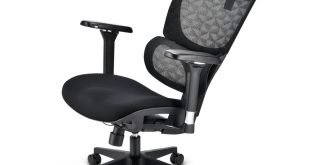A thick piece of foam padding prevents a user's head from contacting the headband's metal support structure. The padding is covered with leather which makes it easy to clean and stops hair sticking to it.
Despite the foam padding's appropriate thickness, the headband doesn't do a good job of taking the headset's 357g load, instead forcing much of the weight to be distributed through the ear cups. One way of improving the headband's ability to distribute weight away from the ear cups would be to increase its surface area.
Unfortunately, it seems that the frame design itself is as much to blame for the less-than-comfortable fit as any other component. Both of the small-diameter metal bars are forced out of their ‘natural' position when the ear cups are fitted around one's head. This makes them want to reside back in their resting position, hence applying a noticeable amount of force on one's ears.
If the bars were designed with a more flexible window of adjustment (perhaps a less stiff material), they would happily lie in the wearing position without placing horizontal forces on the user's ears.
Measuring 10.5cm tall and 8cm wide, I found the ear cups to be of a good comfort level. The previously mentioned design parameters of the headpiece cause a noticeable amount of force to be funnelled through the ear cups, but the thick foam padding does a decent job of lessening the impact against one's ears.
There's no denying that a user's ears will get hot when the GameCom Commander is used, but Plantronics' ear cup design and level of padding does help to make the wearing experience bearable for a good length of time. I welcomed taking them off for a cooling break after a non-stop two hour session on Battlefield 3, but that's a good period of time to find wearing a bulky headset bearable.
My ears didn't feel too squashed into the 65 x 35 mm gaps, either; Plantronics gives them a size which is likely to just about suffice for a large proportion of users.
As far as performance goes, the Plantronics GameCom Commander headset is an excellent contender. We tested a variety of scenarios including; movie viewing, music playback, and FPS gaming. We also tested the microphone via phone and Skype calls.
Gaming performance for the GameCom Commander was excellent. The range of tones and acoustic outputs provided by Battlefield 3 was reproduced with good quality on Plantronics' peripheral. Explosions had a distinct ‘thud' to them, although the bass levels didn't make for the deepest booms, and the high-pitched ring of death by a grenade screeched through the 40mm drivers.
The different pitches rendered by voices from in-game team-mates calling for ammo or repairs were clearly distinguishable amongst the storm of bullets. The different sounds being output from dissimilar weapons were clearly audible; somebody in the distance firing a shotgun could be easily distinguished from a person shooting a machine pistol.
The surround sound worked as well as we would expect when playing Battlefield 3. I was able to identify the footsteps of an enemy ready to melee me from behind or the rotation of a tank's turret as it lined up its anti-armour cannon. The effect and direction of choppers flying past was very distinct, and when using a jet, the surround sound helped me to identify the course of an enemy's anti-air bullet stream.
Movie playback using The Dark Knight helped to re-enforce the point that Plantronics' GameCom Commander headset is able to accurately reproduce a variety of tones to good effect. The Dark Knight's diverse sound track made for great testing, and the GameCom Commander delivered impressive performance. I didn't notice any of the sounds being muffled together, nor were they overwhelmed by a poor balance from another acoustic trait.
Using the Dolby 7.1 surround sound mode for watching a film has clear benefits during an action scene. The Plantronics GameCom Commander's 7.1 Dolby surround sound helped to immerse me in the action scenes of Saving Private Ryan. But the surround sound also has its downsides in speech scenes where the actors' voices can seem to echo.
Listening to a number of songs from the Now 85 album gave further evidence for the GameCom Commander's strong acoustic performance and reproduction of tones. Bass performance could be a little better. Personally, I like the bass to deliver a strong punch (although this can sometimes affect speech clarity), but the GameCom Commander seemed to opt for a more balanced approach.
From the music playback tests, it was clear that the headset's balanced range of effects and tones was very good, even if I would have liked the bass to be a little more thunderous.
Microphone performance was without issues. A number of call recipients could hear my speech without problems. Plantronics' well-designed boom can be thanked for the speech clarity. The 21cm-long, flexible boom can easily be positioned in the appropriate location to make speech clarity as ideal as possible.
The Plantronics GameCom Commander headset has good noise-cancellation performance. Despite its passive, not active, noise-cancellation system, the GameCom Commander was able to drown out low level sounds such as computer fans or birds singing. The closed ear cup design wasn't able to block out key sounds from my Cherry MX Red CM Storm QuickFire TK keyboard, but that's a particularly tough task for any non-active noise-cancelling headset.
 KitGuru KitGuru.net – Tech News | Hardware News | Hardware Reviews | IOS | Mobile | Gaming | Graphics Cards
KitGuru KitGuru.net – Tech News | Hardware News | Hardware Reviews | IOS | Mobile | Gaming | Graphics Cards








